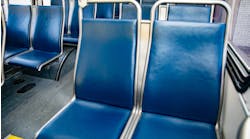BC Transit to begin rolling out bus racks to accommodate fat-tire bikes
Getting off the trails from a ride and onto the bus with your bike will soon be a reality. This month, BC Transit will start phasing in new bike racks to accommodate bikes with tires up to three inches (75 millimeters) across the province.
The use of bike racks is increasing in popularity with transit riders across the province, who use them for a variety of reasons–as part of their commute, as a first mile and last mile solution to help connect them door to door or as a convenient way to go home with their bike after a trail ride. However, bikes come in a number of sizes, and BC Transit’s customers expressed their need for a bike rack that could accommodate bikes with tires larger than the previous two-inch (50.8 mm) maximum allowance.
“The results from our testing indicated that we can safely approve this wide tire bike rack for BC Transit’s customers”, says Jeff Coleman, supervisor, fleet engineering at BC Transit.
Many different bike racks were tested throughout the process and the model that best met BC Transit’s needs for safety and customer convenience was the Apex 2TM by Sportworks. Customers regularly ask about racks that can hold three bikes, and BC Transit tested various three-bike racks. However, the three-bike racks did not meet BC Transit’s safety expectations due to issues with the headlight obstruction. For accessibility and safety reasons, bikes cannot come on board, so bike racks are positioned on the front exterior of each bus.
Rolling out across B.C.
Currently, buses in Whistler, Nanaimo, Kamloops and Squamish are already operating with the bike racks. The bike racks in these communities are the Sportwork model with plastic holders for the bike tires. The new model that will be rolled out province wide, and eventually replace the Sportwork model in these four communities, will look more like our current bike rack with metal tire holders.
In these communities, customers are quick to give high fives and praise for the bike racks. Lewis McCormack, a new Whistler resident, explained that the bike racks on the buses in Whistler are much more accommodating than in his homeland of Scotland.
“I’ve had mechanical [issues] before and I can’t walk or pedal home, so I have to bus home [with my bike],” McCormack shared. “Back home, in Scotland, try to get a mountain bike on a carrier, it’s not good. Here, perfect. Easy peasy.”
The rollout in the rest of BC Transit’s communities will occur in two ways–new buses will be delivered to BC Transit with the new bike racks installed, while existing buses in the fleet will have the bike racks replaced as they are damaged. BC Transit’s fleet size includes 1,080 buses and approximately 914 of those buses have bike racks. While nearly 200 new buses will be purchased with the bike rack installed over the next two years, it is likely to take several years before all buses are equipped with the new rack. According to Coleman, passengers may experience some inconsistency in sizes during the transition time and should plan their transit trips with their bikes accordingly.
The new bike racks are evidence of just how important customer feedback is to delivering the best possible experience. If you have feedback for BC Transit, connect online at bctransit.com.



